Easy Songs With the Notes B a G
Are you a new recorder player looking for some easy songs to get you started?
Do you want a good list of simple recorder songs for your young students?
When you start introducing or playing the recorder, it's often the first experience with playing an instrument that requires breath control and multiple fingering techniques.
As with learning anything new, it helps to learn from easy tasks at first.
I've seen this work well with both my elementary music students and the college ones I teach.
If you do too much, too fast, they quickly get overwhelmed.
This is why I condensed this list of 27 easy songs on a recorder.
Easy songs on a recorder are separated by the number of notes they use. They have easy rhythms and start with notes in stepwise motion. Here are some my favorite beginner recorder tunes:
- Hot Cross Buns
- Go To Sleep
- Au Clair De La Lune
- Merrily We Roll Along
- Rain Rain Go Away
- Closet Key
- Baby Shark
- Let's Go Sports Team, Let's Go!
Look ahead for more details on why I picked each of these.
Also, click the links of the songs for a dedicated post on how to teach the song and notes specifically.
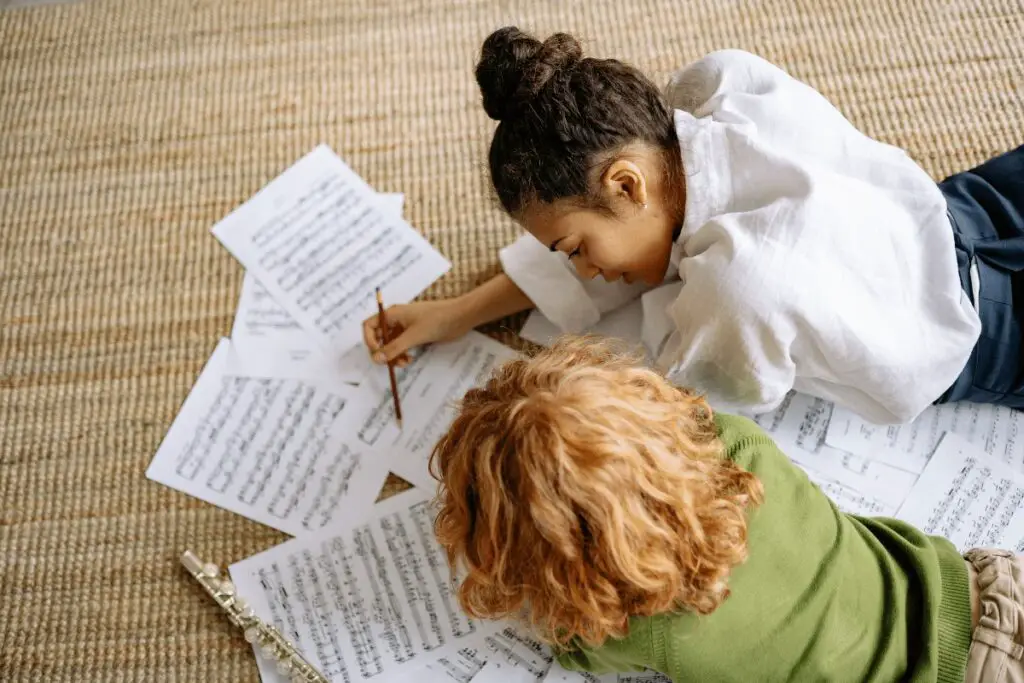
What To Look For In An Easy Song On Recorder
This section talks about what an easy song needs to have in it in order to be considered "easy."
Each of these elements are good to have, but they aren't all needed in order for the song to be simple.
But the more elements there are, the better (at least as far as a lower difficulty goes).
Number Of Different Pitches
The hardest part for most people when playing recorder is getting the fingerings down.
In fact, I do an exercise with my students to prove how important fingering is.
I'll have a student blow a long stream of air while I do the notes on their recorder with the fingers.
I'll play something way more difficult than they may ever get to and point out how if only they knew the fingerings, they could play anything.
Most kids really like this and get motivated.
But if there are a ton of different notes, people get overwhelmed.
An easy song needs to have fewer notes.
3 note songs are the best, but 4 and 5 are OK too as long as the notes move step-wise and there isn't a lot of jumping around.
The first 3 notes which are generally considered the easiest are B-A-G.
High D-high C-A are also pretty easy.
A-G-E are easy as well.
Speaking of songs with tough notes, check out our guide for how to play My Heart Will Go On on recorder (with video!).
Length Of Song
The length of the song also has a direct impact on how long it takes to learn the song.
Often, longer songs have multiple sections and a lot of different material.
This makes it harder for the learner to keep track of all they need to.
It also increases the chances of the student giving up when they make too many mistakes.
Shorter = easier.
Repetitiveness
Along the same lines, if the song re-uses a lot of the same ideas, it'll be easier to learn than if it's new material throughout.
Look at Hot Cross Buns (the classic beginner song).
The song is only 4 measures long, and 3 of them are exactly the same.
Look for songs with repetitive material, and they'll fall into place faster.
Familiar Vs. Unfamiliar
Obviously, if you know the song, you'll pick it up much easier.
I don't just mean if you've played it before.
Even if you've heard it, this makes a big difference.
For example:
The song Baby Shark isn't too hard, but the notes involved are a little tricky.
Still, many students will find it easier to learn this song at first than Au Clair De La Lune because they've heard Baby Shark soooo many times.
Rhythms and Meter Used
With notes as tricky as they are, recorder learners don't need to be distracted by complicated rhythms.
Every song on the list uses only basic rhythms most of the students will have heard by second grade.
Avoid dotted rhythms and triple meter for "easier" songs.
Here's a quick list of easy to achieve rhythms:
- Quarter note
- Quarter rest
- Eighth notes
- Half notes
- Half rest
- Whole notes
- Dotted half notes
- Sixteenth notes
Range
Recorders are known for being picky in the range they play, especially with budget recorders.
Take a look at the best soprano recorder brands.
At their high notes (namely D and above), they won't squeak, but the sound does tend towards the shrill end.
On the lower notes (past low E), the plastic recorders especially are harder to make sound correctly.
These notes squeak easier and always sound a little weak.
An easy recorder song wouldn't go beyond this range for very long.
This isn't to say songs outside this range can't be easy, but they require a skill-set beyond what beginner recorder players usually have to offer.
All songs are based on the soprano recorder, but they'll work well on any type of recorder (click the link to learn more about the types in our guide).
Hey! If you want to get better at the recorder, check out this course on Udemy.
I tried it out to see if my students would get something from it and, wow!, I was impressed.
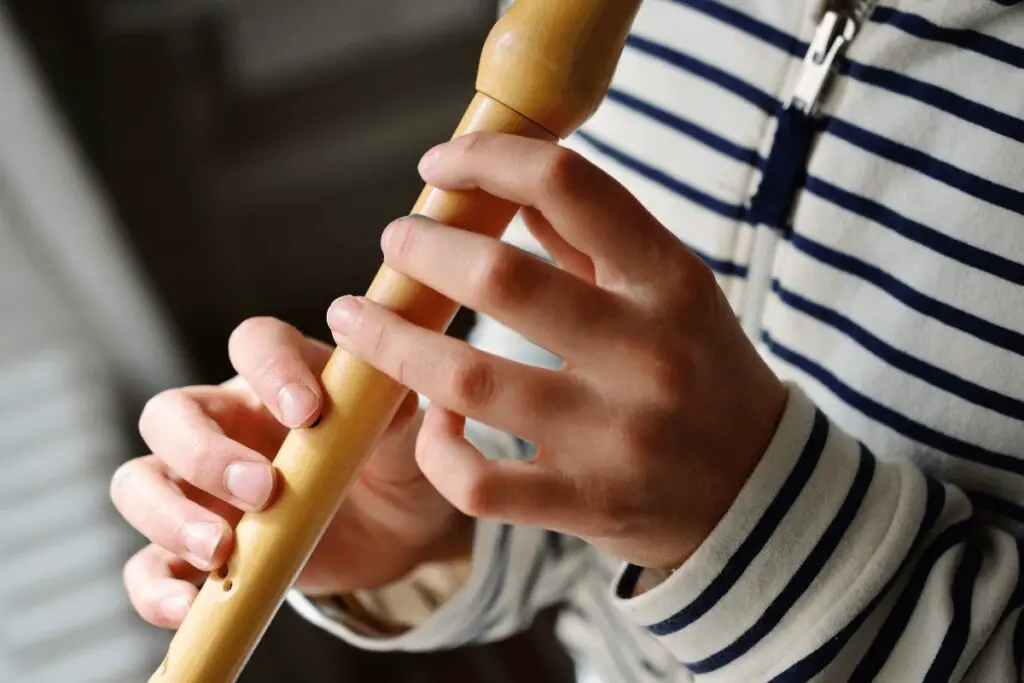
Other Great Recorder Resources
These are some of my favorite recorder song resources.
If you want to expand past the 27 songs in the next section, check out some of these books.
These are affordable and great to pull from. You don't always have to reinvent the wheel.
50 Greatest Classics for Recorder
First 50 Songs You Should Play On Recorder
Easy Pop Melodies For Recorder
Note: These are affiliate links which means we earn a small commission at no extra cost to you. Thanks!
If you want to hear these in video form, check out my review of them in this video.
27 Easy Songs On Recorder
This section covers my favorite 27 easy songs on the soprano recorder.
This is largely a personal list, but it's built on over a decade of teaching and playing the recorder.
Note: For more details on how to teach the songs, click the link to the dedicated page. This article reviews what makes these songs easy.
I'll give a score out of 10 with 1 being the very easiest for each of these songs to help you decide which ones you want to teach.
Hot Cross Buns – 1/10
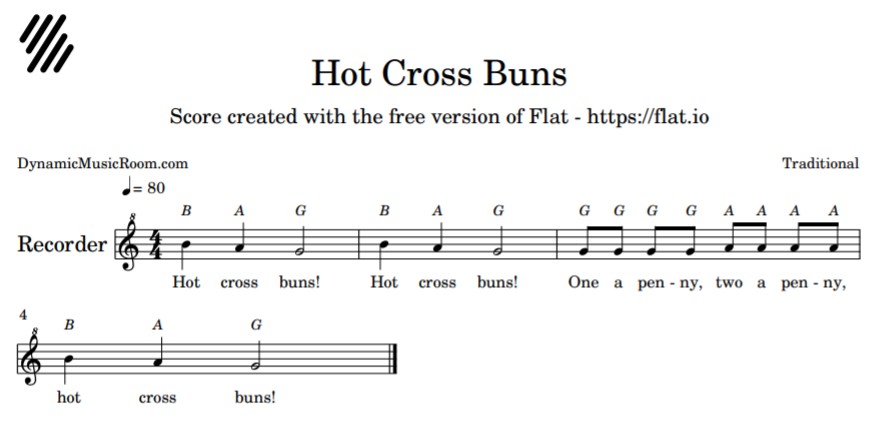
It doesn't get much easier than this.
Hot Cross Buns is almost exclusively the first song taught on recorder (and many many other instruments).
It only uses three pitches: B-A-G.
The rhythms are simple quarter notes, half notes, and eighth notes.
The melody is the same for 3 out of the 4 measures and moves in a descending motion.
All pitch moves are step-wise which is the easier movement, especially with these three notes.
This song's almost a rite of passage for recorder playing. And as much as parents and adults claim to "hate" it even when they were kids, I've never seen students who don't want to play it over and over again.
Go To Sleep – 1/10
Go To Sleep is the anti-Hot Cross Buns in my opinion.
This song uses 3 notes: G-A-B.
If you compare this song to Hot Cross Buns, you'll notice it's almost exactly the same, except inverted.
It's great practice for ascending motion and 3 out of the 4 measures are the same again.
Even better, the rhythm only uses quarter notes and half notes.
This song makes a good partner song with Hot Cross Buns.
Play them at the same time, and it sounds good!
It's never too early to get students into playing harmony on the recorder.
Au Clair De La Lune – 2/10
This is another staple in the recorder world.
The whole melody repeats itself twice, so once you learn one half, you've got the other down!
It only uses 3 notes again: G-A-B.
The rhythms are very simple using only quarter notes, half notes, and whole notes.
The song is beautiful and catchy once mastered.
Au Clair gets one more difficulty point because it introduces the idea of skipping notes.
While the first two were all step-wise, this one features a jump from G → B.
This is fine and not hard to do, although some may struggle with it at first.
Merrily We Roll Along 2.5/10
Merrily We Roll Along (and it's related song Mary Had A Little Lamb) is often the last B-A-G song students learn.
It's a 3 note song with the option of adding high D later on.
The melody is all stepwise with some extra moving up and down which often tricks students up at first.
The rhythms are also simple: quarter notes, eighth notes, and half notes.
The trick with this song comes in its length and form.
Merrily is double as long as most other songs at this level and doesn't reuse a ton of melodic material.
Almost everybody has heard this song which offsets the difficulty somewhat.
Rain Rain Go Away 3/10
Rain Rain Go Away is a 3 note song using different notes.
Depending on the sequence of your preference, you may play it as A-G-E or high D-C-A.
Either one results in a similar difficulty.
The fingering for the lower A-G-E is easier though harder to make speak at first.
D-C-A is higher and easier to sound good, but the fingers are a little trickier.
Either way, this song gets its higher score from jumping around the notes. The rhythm is easy though with quarter notes and eighth notes.
Most people are quite familiar with this one, though, which helps.
Closet Key – 2/10
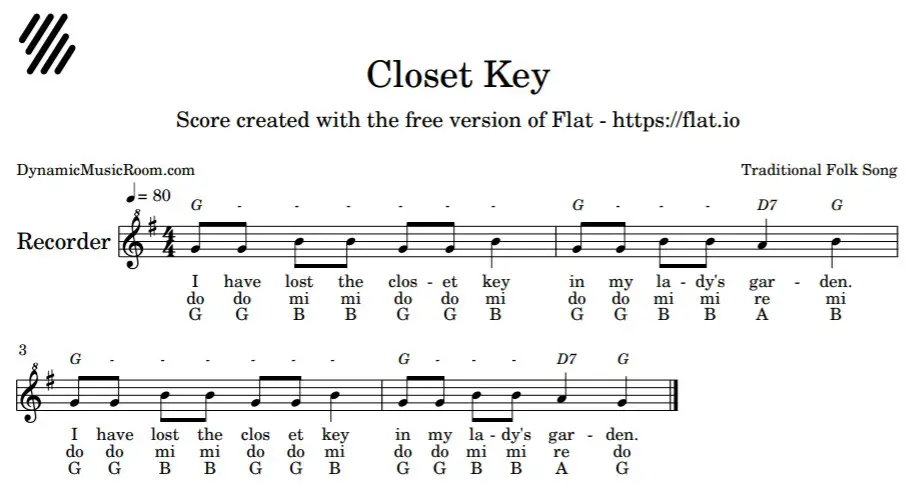
Closet Key is a song similar in function to Au Clair.
It uses 3 notes, B-A-G, and quarter notes and eighth notes for rhythms.
The melody is repetitive and simple to learn.
Actually, I believe many students find this easier even than Merrily or Au Clair.
But since most students don't know this (unless they've had me for a teacher in which case I've taught them in another grade), they sometimes take longer to learn it.
Baby Shark – 3/10
Yep. Baby Shark's on the list.
Go hate on it all you want, but this song is perfect for isolating either the C → B switch or the new note F# depending on the key.
Rhythms are simple: quarter notes, eighth notes, and half notes.
The notes used are either G-A-B-C or D-E-F#-G.
This is the trickiest part and why it gets a 3/10.
However, EVERYBODY has heard this song for better or for worse, so all you need to do is learn the fingerings, not how the song is supposed to go.
Let's Go Sports Team, Let's Go! – 2.5/10
Is this one a true song? Probably not; it's more of a cheer.
But the cheer is great for learning a simple jump from C → A.
Overall, the song only uses 3 notes: C-A-G.
This new note makes it a little tougher, but most people recognize this cheer from any sporting event.
Hint: This is a great way to build school community and maybe get some buy-in from those
too-cool-for-school boys.
Rhythms are easy: quarter notes, eighth notes, quarter rests.
Students even get to clap which really excites them when we learn this song.
Soft Kitty, Warm Kitty – 4/10
This song isn't well-known outside of adults who love the show the Big Bang Theory, but it's still a real song!
As a lullaby, this song is easier than others because it's slower and very repetitive.
Row, Row, Row, Your Boat – 6/10
While not strictly aneasyrecorder song, a lot of kids and adults already know how this song is supposed to go.
As such, learning it feels easier than many other songs they don't know that is actually easier.
Plus! It features a great place to start throwing in some rounds or canon.
Now, we've got more harmony.
Frere Jacques – 3/10
Frere Jacques or Are You Sleeping? is a great and fairly easy tune for people to play on the recorder.
It's much easier than Row, Row, Row Your Boat while still being a tune to help with canon or rounds on the recorder.
Ode To Joy – 5/10
This is another one that's not "easy," though it'll pop up within the first year or two of recorder learning.
It's the highest level of Recorder Karate belt songs (click more to read about it in our article).
It's a beautiful tune from Beethoven's Fifth Symphony and a great launching point to talk about his life.
Check out our whole breakdown on how to play Ode To Joy on the recorder.
Old MacDonald – 4/10
In today's era of kids, they don't know many of the classic kids' songs we grew up with.
But Old MacDonald is one that's stuck around.
Kids often know and love this one, so it's a great one to teach on the recorder.
For notes, it only uses B-A-G-lowE-LowD.
It's Raining, It's Pouring – 3/10
It's Raining, It's Pouring is a good song for practicing the sol-mi-la-sol pattern in singing and on the recorder.
On the recorder, this translates to either practicing:
- G-E-A-G-E
- C-A-D-C-A (high ones)
Either is easy and often early in a recorder method book or curriculum.
Starlight, Starbright – 3/10
This one is very similar to It's Raining.
They use the same notes and cover the same concepts.
At the end of the song, though, you could add in the tonic for an added difficulty in practicing a lower note.
Bingo Was His Name-O – 4/10
Old MacDonald and this song, Bingo was His Name-O, use much of the same notes and ideas.
What I love about this song is how it needs to use added rests as you go on.
You'd be amazed at how it increases student concentration when they play with these little plastic flutes.
Twinkle Twinkle Little Star – 5/10
Of course, everyone knows this song, but it's surprisingly challenging in the notes it uses.
Though the melody is mostly step-wise, making it a little easier, it still uses the first six notes on a major scale.
This challenge is offset by how well it's known to people, so they can easily audiate (or inner hear) the song.
When The Saints Go Marching In – 5/10
Not every person knows this song, but it's a classic for a reason.
It's catchy and lends itself to your ear.
You'd be surprised how quickly adults and kids pick it up, even if they've never heard it before.
Cielito Lindo – 8/10
This isn't a song that really belongs on a list of easy recorder songs at all, but it's a great one for added diversity and accessing the backgrounds of your students.
Cielito Lindo is the perfect song for students who are just about ready to push themselves to include upper octaves notes through the use of the half-hole technique.
Morning Mood – 4/10
If you need a way to practice C pentatonic (CDEGA), then Morning Mood is perfect.
While the notes aren't hard, they're great for jumping up and down and skipping.
Plus, then you can connect to learning about Edvard Grieg.
Pop Goes The Weasel – 4/10
While this song is fast, it doesn't feature many hard notes at all!
I used to have a harder time teaching this song as it's one many students have stopped learning at home over the years.
But since it was featured in Five Nights At Freddy's 2, many of them are more aware of it.
London Bridge Is Falling Down – 3/10
Any time you've taught a song in a younger grade that fits on the recorder, bring it back to learn on the recorder.
It'll make learning the song that much easier!
London Bridge Is Falling Down is one I always bring back as a way to get that dirty F note down.
In fact, many of my fourth graders will ask me if we can play the game after we learn the song!
Here I Come (Lemonade) – 1/10
Here I Come (Lemonade) is a simple tune using only sol-mi (or at most sol-mi-la).
As such, it's perfect for playing C-A or G-E, depending on your preference.
Since I teach it in Kindergarten, this is another good one to bring back for the recorder, and it's incredibly easy.
Plus, with the call and response part, you may even ask students to play one at a time to assess individual skills.
Find the sheet music here at the American Folk Song Collection.
Chicken Wing, Chicken Wing – 3/10
OK, if you're not sick of this song yet, you will be soon.
But my kids LOVE this cheesy little tune.
Surprisingly, it only uses a few notes: D-B-A-G-E.
Check out the sheet music below.
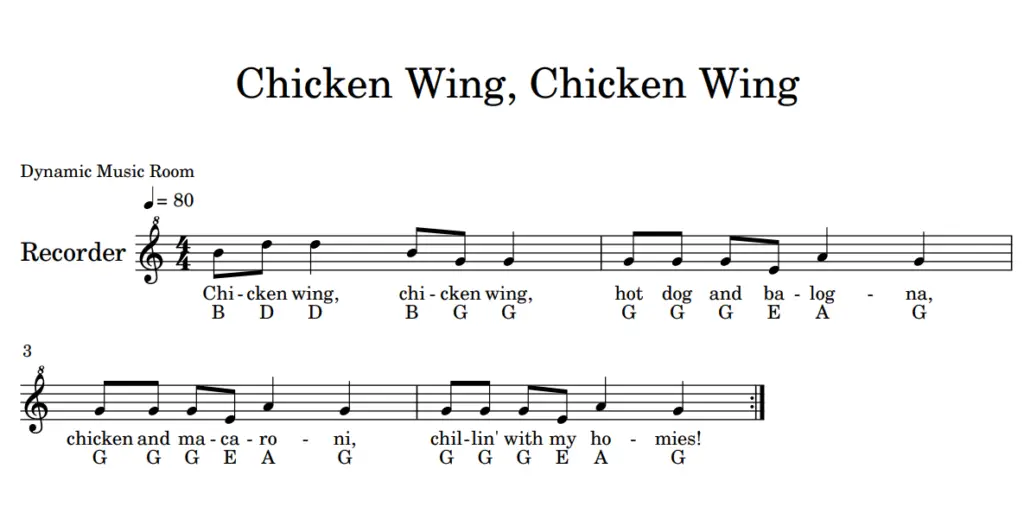
Mary Had A Little Lamb – 2.5/10
Mary Had A Little Lamb is much like Merrily We Roll Along from above, with the exception that you jump up to D on the third "little lamb."
As such, it's a little bit tougher, but many kids will be quick to pick up on the B to D jump if you use this song.
Brahms' Lullaby – 6/10
This beautiful lullaby is doable on the recorder, though it requires the difficult F natural and low C.
With practice, your kids will get it, and it also offers the chance to discuss how performance can make the music better match the feeling of the song.
Never Gonna Give You Up – */10
Is this song easy for your kids?
No way!
Will it be a fun way to inspire and challenge them to learn more difficult rhythms and jump all over their recorder?
Absolutely!
Commonly Asked Questions
What's the easiest song to play on the recorder? – This is truly a matter of opinion, but I believe Hot Cross Buns is the overall easiest.
It uses 3 notes, is very repetitive, and is well-known.
Is the recorder hard to play? – Yes and no.
Compared to most other instruments, the recorder is easy to learn.
However, it takes time to master like any other instrument.
It's also often the first instrument taught to require air control and fingerings which makes it hard for many at first.
Are wooden recorders better than plastic ones? – Mostly yes. They're usually a bit more fragile, but the sound quality is head and shoulders above plastic ones.
We tend to use plastic in schools because they're cheaper and can stand a beating a little better.
Conclusion
I hope you find this list of 27 easy songs on recorder useful in your classroom or to improve your recorder skills.
I love teaching recorders and your students will love these songs too.
These are extra useful when your students are struggling and you need to dig another song out to get their foundation secure.
Picking easy songs is the first place to go, but when it comes to really learning the recorder, you need a plan.
Check out my guide on how to play the recorder which also covers practice techniques, how to create good sound, and resources to check out.
Source: https://dynamicmusicroom.com/easy-songs-on-recorder/
0 Response to "Easy Songs With the Notes B a G"
Post a Comment